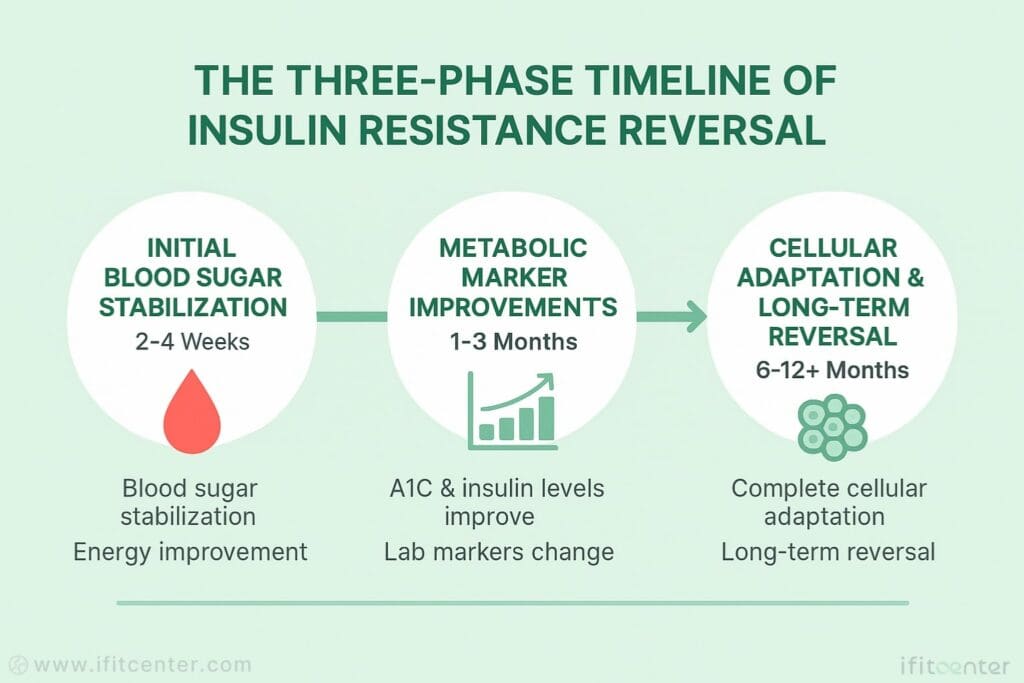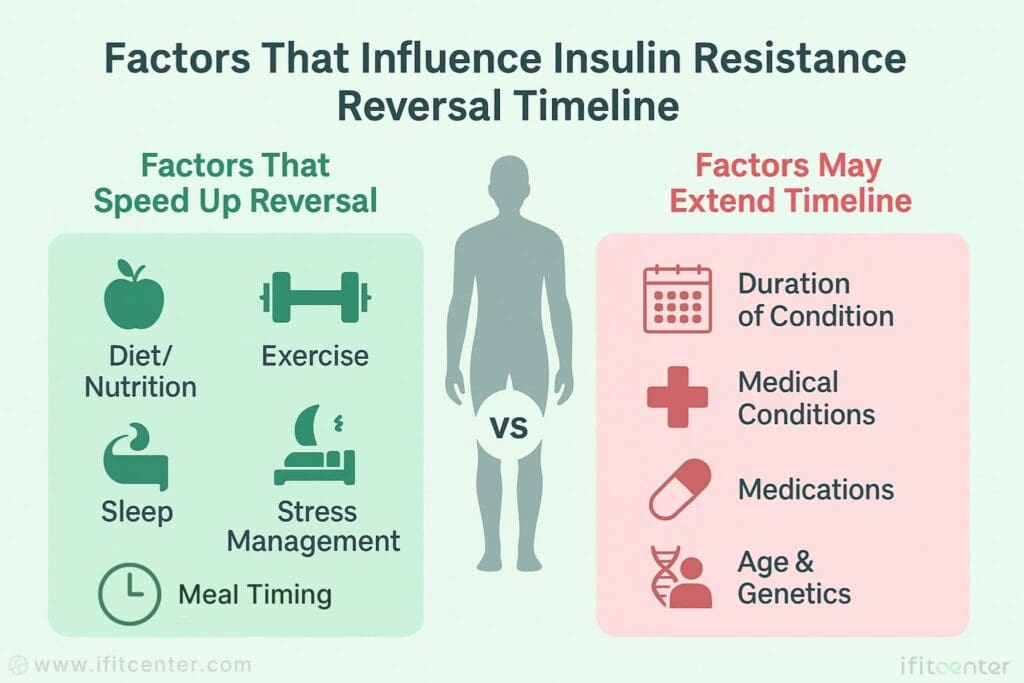“Will it take months or years to reverse my insulin resistance?” “Why haven’t I seen results yet?” “Is complete reversal even possible?” These questions reflect the frustration many people feel when working to improve their metabolic health. If you’re asking similar questions, you’re not alone—and you deserve clear answers.
Insulin resistance doesn’t develop overnight. Your body’s decreasing response to insulin happens gradually over years, often silently, until symptoms finally appear. The reversal process follows a similar pattern—but in reverse. At IFitCenter, we’re examining the complete timeline of insulin resistance reversal to help you set realistic expectations and recognize your progress, even when it seems slow.
What many don’t realize is that reversal happens in distinct phases. While blood sugar readings might improve within weeks, deeper cellular changes take considerably longer. It’s similar to how a garden recovers after years of neglect—you might clear the weeds quickly, but restoring soil health and establishing strong new growth requires patience and consistent care.
In this comprehensive guide, we’ll break down the scientific timeline for reversing insulin resistance, explain the factors that influence your personal journey, and help you recognize meaningful progress at each stage—so you can stay motivated through the entire process.
The Three-Phase Timeline of Insulin Resistance Reversal

Reversing insulin resistance is a journey that happens in stages, not all at once. Understanding these phases can help you recognize progress and stay motivated, even when changes seem slow.
Phase 1: Initial Blood Sugar Stabilization (2-4 Weeks)
Within the first month of making dietary and lifestyle changes, your body begins to respond. This first phase is like taking your foot off the gas pedal—you start slowing down right away, but it takes time to completely stop.
What you might notice during these first few weeks:
- More stable energy levels throughout the day
- Fewer hunger pangs and cravings
- Improved morning blood sugar readings
- Some weight loss, especially around the waist
These quick improvements happen mainly because you’re putting less glucose into your system, giving your body a chance to catch up. Your fasting blood sugar often improves first, sometimes moving from pre-diabetic ranges toward more normal levels.
However, this doesn’t mean insulin resistance itself has reversed yet. Think of this phase as turning down the pressure, not fixing the underlying issue. It’s an encouraging start, but just the beginning of your journey.
Phase 2: Metabolic Marker Improvements (1-3 Months)
After the first month, deeper changes begin. This second phase is when the improvements show up in your lab results, not just in how you feel.
During months 1-3, you’ll likely see changes in:
- A1C levels (your 3-month blood sugar average)
- Fasting insulin levels (often decreasing)
- Triglycerides and cholesterol numbers
- Waist circumference and body composition
Your body is now adapting to the healthier conditions you’ve created. Cells begin responding better to insulin, and your pancreas doesn’t need to produce as much to manage your blood sugar. Inflammation starts decreasing throughout your body, and fat storage in the liver begins to reduce.
This phase is when many people feel they’ve “turned the corner” on their health. You might notice your clothes fitting differently, having more energy for exercise, and feeling less bloated or puffy.
The changes happening now build the foundation for long-term health, but the deeper cellular healing is still underway. This is a good time to get follow-up testing to see your progress and stay motivated.
Phase 3: Cellular Adaptation and Long-term Reversal (6-12+ Months)
The final phase takes the longest but delivers the most profound healing. Over 6-12 months or more, your body undergoes the deep cellular changes that represent true insulin resistance reversal.
Think of this phase like rehabilitating after an injury. The pain disappears quickly, basic function returns within weeks, but full strength and flexibility take months of consistent work.
During this extended phase:
- Cells fully restore their insulin sensitivity
- Your body requires less insulin to maintain normal blood sugar
- Metabolic flexibility returns (the ability to easily use both sugar and fat for energy)
- Long-standing cellular “habits” are reset
Research shows that the longer insulin resistance has been present, the longer complete reversal typically takes. Your cells have essentially developed habits based on years of metabolic dysfunction, and they need time to fully adapt to healthier conditions.
This longer timeline isn’t discouraging—it’s realistic. Understanding that complete reversal takes time prevents the frustration that leads many people to give up too soon. The gradual improvement allows your body to adapt sustainably rather than experiencing the rebound that often follows quick fixes.
The patience required during this phase pays off with significant health benefits: reduced disease risk, increased energy, better quality of life, and a foundation for long-term metabolic health that can last for decades.
On the IFitCenter blog, we have published a free content bank about insulin resistance that can have a significant impact for you in controlling and preventing this metabolic disease. For access, simply use the links below:
- what is insulin resistance
- how do you reverse insulin resistance
- insulin resistance symptoms
- how to test for insulin resistance
- supplements for insulin resistance
Factors That Influence Your Insulin Resistance Reversal Timeline

While everyone follows a similar path to reversing insulin resistance, some people see results faster than others. Let’s look at what can speed up your progress and what might slow it down.
Factors That Speed Up Insulin Resistance Reversal
Diet Choices: Reducing carbs, especially refined ones and sugars, lowers your body’s insulin demand immediately. Including protein with meals helps moderate blood sugar spikes, while healthy fats provide energy without raising insulin levels.
The Right Exercise: Strength training builds muscle that soaks up glucose from your bloodstream. Even brief, intense exercise sessions can improve insulin sensitivity for up to two days afterward. Consistency matters more than intensity.
Quality Sleep: Poor sleep can temporarily worsen insulin resistance. Aim for 7-8 hours nightly to allow your body to repair and regulate hormones properly.
Managing Stress: High stress raises cortisol, which increases blood sugar and insulin resistance. Simple daily practices like deep breathing or short walks can make a significant difference.
Meal Timing: Giving your body breaks between meals by limiting eating to an 8-10 hour window each day can help restore insulin sensitivity faster than eating throughout the day.
Factors That May Extend Your Timeline
How Long You’ve Had It: The longer you’ve had insulin resistance, the more time it typically takes to reverse. Patterns established over decades don’t change overnight.
Health Conditions: PCOS, thyroid disorders, and inflammatory conditions can complicate and slow down the reversal process. These conditions often require additional targeted strategies.
Medications: Some medications like certain antidepressants, steroids, and antipsychotics can promote insulin resistance. Never stop prescribed medications, but discuss options with your doctor.
Age and Genetics: Insulin sensitivity naturally decreases with age, and family history plays a role in how quickly you can improve. These factors don’t prevent reversal but may extend your timeline.
Even with these challenges, improvement is still very possible. The key is consistency and patience. Many people with multiple complicating factors have successfully reversed their insulin resistance—it just required more time and personalized approaches.
How to Track Your Progress and Know You’re on the Right Path
Tracking your progress helps you stay motivated and confirms you’re moving in the right direction. Here’s what to monitor along your journey.
To access the second part of the insulin resistance content, I invite you to use the links below:
- food for insulin resistance
- insulin resistance symptoms in kids
- how to stop insulin weight gain
- insulin resistance and diabetes
- Can Fasting Reverse Insulin Resistance?
The Right Metrics to Monitor
Several lab tests can track your insulin resistance reversal:
Fasting Blood Glucose: Often the first number to improve, sometimes within weeks of dietary changes. Morning readings moving toward normal ranges (under 90 mg/dL) suggest you’re on the right track.
Hemoglobin A1C: Reflects your average blood sugar over three months. Expect changes after 2-3 months of consistent effort.
Fasting Insulin: This directly measures insulin resistance. As sensitivity improves, these levels decrease, typically within 1-3 months.
HOMA-IR: Combines fasting glucose and insulin to provide a complete picture of insulin resistance. Values below 1.0 indicate good insulin sensitivity.
Standard medical testing often focuses only on glucose and A1C. If possible, request fasting insulin testing for a better understanding of your status. Testing every 3-4 months allows time for meaningful changes.
Beyond the Numbers: Functional Improvements
Some of the most meaningful signs of progress won’t show up on lab tests:
Energy Levels: Stable energy throughout the day without afternoon crashes is often one of the first improvements.
Hunger and Cravings: As insulin levels normalize, you’ll likely notice less intense hunger, fewer cravings, and longer periods of feeling satisfied after meals.
Mental Clarity: Many people report improved concentration and less “brain fog” as insulin sensitivity improves.
Sleep Quality: Better blood sugar regulation often leads to improved sleep quality and feeling more refreshed in the morning.
Consider tracking these daily improvements—they provide motivation and confirmation that your efforts are working, even before lab tests show dramatic changes.
Conclusion: Your Insulin Resistance Reversal Journey
Reversing insulin resistance follows a predictable timeline, though the pace varies from person to person. The journey typically begins with blood sugar stabilization in the first few weeks, progresses to deeper metabolic improvements over 1-3 months, and culminates in true cellular healing over 6-12 months or longer.
The encouraging news is that insulin resistance is reversible for most people. Your body has a remarkable ability to heal when given the right conditions. The consistent dietary and lifestyle changes that improve insulin sensitivity also enhance overall health, energy, and quality of life.
Patience and consistency are your most powerful allies in this process. Quick fixes don’t address the deep cellular adaptations needed for lasting change. Small, sustainable actions maintained over time yield far better results than dramatic but short-lived efforts.
Remember that your journey is uniquely yours. Your timeline will reflect your individual circumstances – how long you’ve had insulin resistance, your genetic factors, your consistency with lifestyle changes, and your overall health picture. The path to better health isn’t a competition but a personal journey of improvement.
The benefits of reversing insulin resistance extend far beyond improved lab values. Better energy, clearer thinking, improved mood, higher quality sleep, and reduced risk of numerous chronic diseases make the effort worthwhile. Each step you take toward better insulin sensitivity is an investment in your long-term health and vitality.
To access other content on the IFitCenter’s blog, you can use the following links:
References
- American Diabetes Association. (2024). “Standards of Medical Care in Diabetes.” Diabetes Care, 47(Supplement 1). Available at: https://diabetesjournals.org/care/issue/47/Supplement_1
- Ludwig, D. (2020). “Always Hungry?: Conquer Cravings, Retrain Your Fat Cells, and Lose Weight Permanently.” Grand Central Life & Style.
- Dr. Robert Lustig (University of California) – Expert on metabolic syndrome and sugar’s role in insulin resistance
- Malin, S.K., et al. (2018). “Independent and Combined Effects of Exercise Training and Metformin on Insulin Sensitivity in Individuals With Prediabetes.” Diabetes Care, 41(7), 1527-1534. DOI: 10.2337/dc18-0520
- Magkos, F., et al. (2016). “Effects of Moderate and Subsequent Progressive Weight Loss on Metabolic Function and Adipose Tissue Biology in Humans with Obesity.” Cell Metabolism, 23(4), 591-601. DOI: 10.1016/j.cmet.2016.02.005



